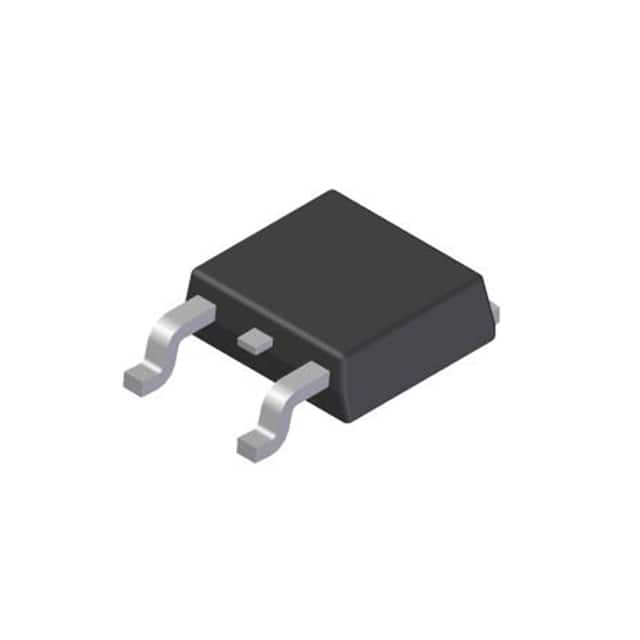SBR15U100CTLQ-13
Product Overview
Category
The SBR15U100CTLQ-13 belongs to the category of Schottky Barrier Rectifiers.
Use
It is commonly used in power supply and voltage regulation applications.
Characteristics
- Low forward voltage drop
- High current capability
- Fast switching speed
Package
The SBR15U100CTLQ-13 is typically available in a TO-220AB package.
Essence
This rectifier is essential for converting alternating current (AC) to direct current (DC) with minimal power loss.
Packaging/Quantity
It is usually packaged in reels or tubes, with quantities varying based on manufacturer specifications.
Specifications
- Maximum Average Forward Current: 15A
- Maximum Reverse Voltage: 100V
- Forward Voltage Drop: 0.65V at 7.5A
- Reverse Leakage Current: 10μA at 100V
Detailed Pin Configuration
The SBR15U100CTLQ-13 has three pins: 1. Anode 2. Cathode 3. Gate
Functional Features
- Low power loss
- High efficiency
- Suitable for high-frequency applications
Advantages
- Reduced heat generation
- Enhanced system reliability
- Faster switching times
Disadvantages
- Higher cost compared to standard rectifiers
- Limited availability from certain suppliers
Working Principles
The SBR15U100CTLQ-13 operates based on the Schottky barrier principle, where a metal-semiconductor junction is formed to allow for low forward voltage drop and fast switching characteristics.
Detailed Application Field Plans
This rectifier is widely used in: - Switching power supplies - DC-DC converters - Voltage regulation circuits
Detailed and Complete Alternative Models
Some alternative models to consider are: - SBR10U45SP5-7 - SBR20U30SP5-7 - SBR30U60CTB-7
In conclusion, the SBR15U100CTLQ-13 is a versatile Schottky Barrier Rectifier with excellent performance characteristics, making it suitable for various power supply and voltage regulation applications. Its low forward voltage drop, high current capability, and fast switching speed make it an ideal choice for efficient energy conversion. While it may have a higher cost and limited availability from certain suppliers, its advantages in terms of reduced heat generation and enhanced system reliability make it a valuable component in electronic systems.
قم بإدراج 10 أسئلة وإجابات شائعة تتعلق بتطبيق SBR15U100CTLQ-13 في الحلول التقنية
What is the SBR15U100CTLQ-13 used for in technical solutions?
- The SBR15U100CTLQ-13 is a Schottky barrier rectifier diode commonly used for power supply, voltage regulation, and reverse polarity protection in various technical solutions.
What are the key specifications of the SBR15U100CTLQ-13?
- The SBR15U100CTLQ-13 has a maximum average forward current of 15A, a reverse voltage of 100V, and a low forward voltage drop, making it suitable for high-efficiency applications.
How does the SBR15U100CTLQ-13 compare to other diodes in similar applications?
- The SBR15U100CTLQ-13 offers lower forward voltage drop and faster switching speed compared to standard silicon diodes, making it ideal for high-frequency and high-efficiency designs.
Can the SBR15U100CTLQ-13 be used in automotive applications?
- Yes, the SBR15U100CTLQ-13 is suitable for automotive systems such as power management, motor control, and LED lighting due to its high reliability and temperature stability.
What are the thermal considerations when using the SBR15U100CTLQ-13 in technical solutions?
- Proper heat sinking and thermal management are important to ensure the SBR15U100CTLQ-13 operates within its specified temperature range for optimal performance and longevity.
Are there any application notes or reference designs available for the SBR15U100CTLQ-13?
- Yes, the manufacturer provides application notes and reference designs to assist engineers in implementing the SBR15U100CTLQ-13 in various technical solutions.
Can the SBR15U100CTLQ-13 be used in parallel to increase current handling capability?
- Yes, the SBR15U100CTLQ-13 can be used in parallel to increase the overall current handling capability while maintaining low forward voltage drop.
What are the typical failure modes of the SBR15U100CTLQ-13 and how can they be mitigated?
- Common failure modes include thermal runaway and reverse voltage breakdown. These can be mitigated by proper thermal design, overvoltage protection, and current limiting.
Is the SBR15U100CTLQ-13 suitable for high-frequency switching applications?
- Yes, the SBR15U100CTLQ-13's fast recovery time and low capacitance make it well-suited for high-frequency switching applications such as DC-DC converters and inverters.
Where can I find detailed application examples using the SBR15U100CTLQ-13 in technical solutions?
- Detailed application examples can be found in the product datasheet, application notes, and online technical forums where engineers share their experiences with the SBR15U100CTLQ-13.


